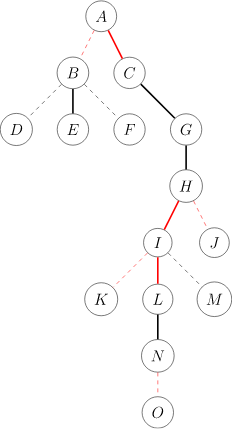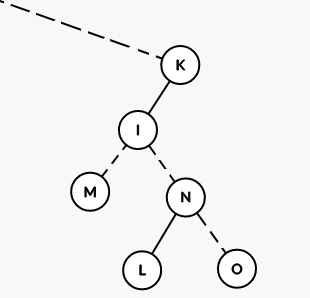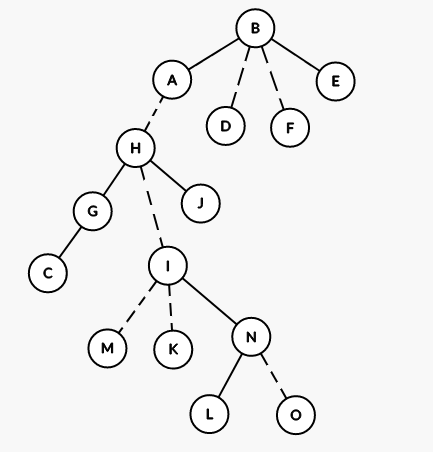樱雪喵用时 3days 做了 ybtoj 的 3 道例题,真是太有效率了!!1
写死自己系列。
为了避免自己没学明白就瞎写东西误人子弟,这篇 Blog 拖到了现在。
图片基本沿用 OIwiki,原文跳步骤(主要是 access 部分)的就自己补画了一些。
不过反正也没啥人看?
前置知识
Splay
欢迎阅读 Splay 详细图解 & 轻量级代码实现。
其实 LCT 对 Splay 的要求主要体现在维护序列的能力上,如果平时更习惯用其它平衡树,单纯为了学 LCT 去学 Splay 的话,“应用”那一段都不用看,会 rotate & splay & reverse 以及维护一些简单的序列操作(区间加区间乘?)就足够了。
据说无旋 Treap 也能用来维护 LCT,但复杂度多一个 \(\log\),不建议大家这么写。不过如果真的痛恨 Splay 也可以去学学:Link
下文 Splay(大写)表示树,splay(小写)表示操作。
树链剖分
没写过博客,但应该没人学 LCT 不会这个吧。
动态树
动态树,顾名思义就是维护一个森林,支持连边和删边操作,要求维护树上的一些特定信息。
LCT(link cut tree),是一种解决动态树问题的数据结构。LCT 不叫动态树。
实链剖分
基于上文对动态树问题的概述,我们以 lg P3690 【模板】动态树(LCT) 为例看看 lct 具体用来干什么。
假设有这样的问题。
给一棵树,要求支持如下操作:
- 修改一个点的点权
- 查询路径 \(x\) 到 \(y\) 的点权异或和
不难想到,这个问题容易使用重链剖分在 \(O(n\log n)\) 的时间复杂度内解决。
但如果这个森林是动态的,即改成支持如下操作:
- 修改一个点的点权
- 断开 \(x\) 和 \(y\) 之间的连边
- 在 \(x\) 和 \(y\) 之间连一条边,保证连边后还是一个森林
- 查询路径 \(x\) 到 \(y\) 的点权异或和
朴素的静态树链剖分难以维护这个问题,因为我们在改变树的结构时,树链剖分的形态也应随之改变。我们需要换一种方法来解决问题。
考虑重链剖分维护链上操作的本质,是给同一条链上的点赋上相邻的 \(dfn\) 编号,并保证从叶子到根经过的链的条数为 \(\log\) 级别,从而方便使用其他数据结构维护。
而在动态树中,问题的瓶颈变成了怎么让树链的划分状况随树的形态快速修改。考虑沿用重链剖分的思路,发现 \(size\) 是难以维护的;那我们显然更希望每个点的轻重儿子是我们自己指定的,而不是遵守特定的规则,这样在改变树形态的时候可以更自由地维护树链的变化。
我们把这种“自己指定轻重儿子”的剖分方式成为实链剖分,同一条链里的点之间连的边叫做实边,不同链之间的边叫虚边。其中每个点用实边相连的儿子叫实儿子,其余的叫虚儿子。
虽然这样划分是很自由的,但要注意它和树剖的区别:
- 每个非叶子节点至多有一个实儿子,但也可以一个都没有;
- 由上条可知,一条实链不一定要一直延伸到叶子节点。
现在,这棵树被我们划分成了若干实链。考虑使用 Splay 来分别维护这些链。对于一个链上的整体操作,我们就通过对这棵 Splay 维护区间操作来实现。
辅助树
在学习 LCT 的操作之前,要先了解辅助树的定义及其结构。
辅助树,就是维护每个树链的 Splay 之间通过某种方式相连接形成的树形结构。可以认为,Splay 维护的是一条实链,辅助树维护的是一棵树;一些辅助树放在一起就形成了 LCT,LCT 维护的是整个森林。
它满足如下性质:
- 辅助树由多棵 Splay 构成,其中每棵 Splay 维护的是原树的一条实链,且这棵 Splay 的中序遍历一一对应实链从上到下的点;
- 原树的每个点和辅助树上的点一一对应;
- 辅助树上的 Splay 之间通过某种方式连接成树形结构。具体地,我们原来学习的 Splay 根节点为空,但辅助树上的 Splay 不同,维护每条实链的 Splay,它根节点的父亲指向 这条实链顶端的点的父亲。注意不是指向 Splay 根节点在原树上的父亲。同时,对于根节点的父亲,它的两个儿子均不指向该点,这表示这条边是虚边。也就是说,所有实边是双向连接的;而虚边认父不认子,只能从儿子找父亲,父亲找不到儿子。我们可以根据这点来判断哪些点是 Splay 的根节点。
- 根据以上性质,我们在原树上所要进行的操作都可以在辅助树上进行,故下文的操作若无特别说明,均基于辅助树。
举个例子,一棵长成这样的树(实线为实边,虚线为虚边):

它的一种辅助树就可以长成这样(不认为这张图很难理解,所以直接贺过来了):

学习 Splay 时,我们记得同一个序列能构成的 Splay 有很多种不同形态,LCT 是同理的,对于相同的树形态和虚实边划分,由于 Splay 形态的不同,可以有很多种形态不同的辅助树。
那么我们得到了辅助树和原树之间的关系:
- 原树的实链都在辅助树的同一个 Splay 中;实边在 Splay 里中序遍历相邻,但不一定直接有边相连。
- 原树的虚边,由儿子所在 Splay 的根节点指向该点,但该点不指向虚儿子。
- Splay 上虽然至多只有两个实儿子,但剩下多出来的都是虚边,虚边可以有很多条。
- 原树的根不等于辅助树的根,辅助树在不破坏 Splay 性质的情况下可以随意换根。
- 原树的 father 指向和辅助树不同,注意区分。
- 在辅助树上,更易于进行虚实链之间的变换,这一点会在后文进行讲解。
常用函数的实现 - Splay 原有函数
知道了实链剖分和辅助树的概念,就可以开始实现 LCT 的一些常用函数了 qwq。
LCT 里使用的 Splay,由于根节点父亲不为空的定义与普通 Splay 不同,在写法上也需要做出一些改动。
我们先从简单的开始:
get
判断 \(x\) 是它父亲的哪个儿子。在 Splay 里面学习过了,不用改动。
il bool get(int x) {return rs(fa(x))==x;}
isroot
LCT 独有的函数,判断 \(x\) 是否为这棵 Splay 的根。
根据虚边认父不认子的性质,如果 \(x\) 父亲的两个儿子都找不到它,这条连边就是虚边,即 \(x\) 是 Splay 的根。
il bool isroot(int x) {return ls(fa(x))!=x&&rs(fa(x))!=x;}
pushup
在儿子节点改变时上传信息。以上文所述的题意为例,我们需要在 pushup 中更新这棵 Splay 的异或和。
il void pushup(int x)
{
// pushup other things here
tr[x].sum=tr[x].key^tr[ls(x)].sum^tr[rs(x)].sum;
}
pushdown
下传标记。
LCT 绝大部分时候都要在 Splay 上维护区间翻转标记,原因后文会讲。同时,根据题里的要求打的其他标记(这道题没有)也要一起下传。
这里和文艺平衡树一样,翻转标记有两种不同含义的写法:
- 一种是打标记的时候,这个点左右儿子已经换过了,标记表示它的两个儿子要换左右儿子;
- 另外一种是打标记表示这个点要换左右儿子,但现在还没换。
两种写法没有什么本质区别,但在后面一些地方 pushdown 的顺序写起来不一样。后文遇到有区别的地方会提到。
另外有些题,点 \(x\) 维护的信息与左右儿子的顺序有关。这个时候第二种就是错的,只能用第一种写法。 后文有相关例题。
这里为了代码简单,写的是第二种。
il void pushdown(int x)
{
// pushdown other tags here
if(!tr[x].lz) return;
swap(ls(x),rs(x)),tr[ls(x)].lz^=1,tr[rs(x)].lz^=1;
tr[x].lz=0;
}
update
update(x) 表示从 \(x\) 所在 Splay 的根开始,沿从根到 \(x\) 的链一路下放标记。
用于在 Splay(x) 前,保证 \(x\) 旋转时一路要经过的点的左右儿子都是正确的。
递归下放即可。
il void update(int x)
{
if(!isroot(x)) update(fa(x));
pushdown(x);
}
rotate
与原义相同,把 \(x\) 向上旋转一层。
写法上和在 Splay 中学习的略有区别,因为我们要判断 \(y\) 是否是根,不能再简单地根据 \(z\) 的值是否为 \(0\) 来判断。
而把 \(y\) 和父亲的连边断开再判断会造成 isroot(y) 失效,所以我们把这句话提到前面:
il void rotate(int x)
{
int y=fa(x),z=fa(y),c=get(x);
if(!isroot(y)) tr[z].s[get(y)]=x; // here
fa(tr[x].s[c^1])=y,tr[y].s[c]=tr[x].s[c^1],tr[x].s[c^1]=y;
fa(y)=x,fa(x)=z; pushup(y),pushup(x);
}
Splay
把判断是否为根的语句换成 isroot 即可。注意 Splay 之前要先 update 这条路径,防止出现左右儿子顺序不对/未下传的标记跑到别的节点上的情况。
LCT 不需要形如把 \(x\) 转到某个点儿子的 Splay 函数,因为区间操作都是对整棵树操作。
il void splay(int x)
{
update(x);
for(int f=fa(x);f=fa(x),!isroot(x);rotate(x))
if(!isroot(f)) rotate(get(f)==get(x)?f:x);
}
常用函数的实现 - LCT 的新函数
Splay 中出现过的基本函数到这里就讲完了,已经承包了 LCT 的绝大部分码量!
下文将对 LCT 特有的函数逐一讲解,或许不再像上文那么容易理解,但代码都非常简短(确信。
access
access(x) 的作用是把 \(x\) 到原树的根这条路径上的边都变成实链,同时其他原来与这条路径相连的实边都变成虚边。
换句话讲,把 \(x\) 到根的路径放到同一棵 Splay 里,而且这棵 Splay 里没有这条路径以外的点。
这是 lct 最基本的函数,写任何 lct 都必须要实现 access 操作。
注意要时刻分清楚原树的根和辅助树的根。
后面读到哪里发现读不懂就往上翻翻加粗的字,看看是不是什么地方混淆了概念 >_<(樱雪喵学的时候一直反反复复把概念搞混,所以看了一天才看懂(哭)
下面图比较多,为了避免来回翻页的痛苦把图缩小了(但貌似还是要来回翻页)。看不清可以单击放大,不过应该不至于(
还是以一开始举例子那张图为例,原树长这样:

辅助树长这样:

现在执行 access(N),我们希望它的原树变成这样:

当然辅助树会变成什么样我们还想象不出来,不过不急。
一步一步来。
我们要 access(N),那先把辅助树上的 \(N\) Splay 到根吧:

然后发现,要的是从 \(N\) 到原树的根的这条链,但是我们不想要 \(N\) 在原树上的儿子。原来的虚儿子当然不用管;只要把原来 \(N\) 的实儿子变成虚儿子就好了。
考虑原来 \(N\) 的实儿子在什么地方。根据 Splay 的性质,它的中序遍历是这个实链从上到下的点的顺序。那 \(N\) 在原树上的实儿子就是在现在的 Splay 上根节点的后继。
当然不用麻烦地去找后继在哪里,因为凡是 \(N\) 下面的链上的我们都不要。那直接把 \(N\) 的右儿子和 \(N\) 断开,改成虚边就可以了。
根据虚边认父不认子的性质,我们单方面地把 rs(N) 置为 \(0\)。
现在这条边变成了虚边:

接下来,我们已经根据 \(N\) 在辅助树上的的父亲,知道了链头在原树上的父亲是 \(I\)。也就是说我们想把 \(L\to N\) 这条链 接在 \(I\) 下面。
同样把 \(I\) splay 到根。这里 splay 的时候不会改变虚儿子指向 \(I\) 的虚边,一定要理解哪些边会跟着点的旋转跑,哪些不会(比如根的父亲这条边)。

现在我们希望 \(N\) 这棵树接在 \(I\) 下面,即 \(I\) 在 Splay 上的右儿子;但是 \(I\) 在 Splay 上已经有右儿子了,这意味着现在的 \(I\) 有实儿子。那么我们要把这个点 \(K\) 变成虚儿子,然后把 \(N\) 所在的这条链变成实儿子。
同样地,单方面令 rs(I)=N 即可。

现在 \(I\to L \to N\) 在一个实链里了。同理,我们按照上面的步骤继续。
因为 \(I\) 的父亲是 \(H\),代表这条实链顶端的父亲是 \(H\)。所以我们把 \(H\) Splay 到根:

然后把 \(H\) 的右儿子换成 \(I\):

继续 Splay(A) 并令 rs(A)=H,相信大家能画明白怎么转,这里不分步了。

发现现在原树上 \(A\to C\to G\to H\to I\to L\to N\) 这条链正好在一棵 Splay 里了。
我们再回顾一下刚刚是怎么转的:
- 把当前节点 splay 到根;
- 令它的右儿子等于上次旋转的节点,并 pushup;
- 跳到当前点的父亲,重复以上步骤。
说了这么多,代码就一行,\(p\) 表示上次转的点。
il void access(int x) {for(int p=0;x;p=x,x=fa(x)) splay(x),rs(x)=p,pushup(x);}
makeroot
另一个重要的 lct 函数,写绝大部分题时都需要实现。不过确实有例外,比如 lg P4332 [SHOI2014] 三叉神经树 这种保证深度递增的题就不用写。
在维护一个路径信息时,往往不能保证路径深度递增,很多时候路径是先向上再向下的。根据辅助树的性质,这样的路径无法出现在同一棵 Splay 里。
但是我们还想维护它的信息,怎么办呢。
可以把原树的根换掉啊。makeroot(x) 的作用就是把 \(x\) 换成原树的根。
但是 Splay 里的点是按中序遍历从上到下存的,设原来的原树根是 \(rt\),考虑换成 \(x\) 会对哪些点的上下顺序产生影响:
只有 \(x\) 到 \(rt\) 这条路径上的点上下顺序反过来了,剩下的都没变。上下顺序反过来,貌似就是把这一段的 Splay 区间翻转?
那我们先 access(x),把 \(x\) 到 \(rt\) 弄到一棵 Splay 上。但你发现你不知道 access 完 Splay 的根是啥。所以 splay(x) 让 \(x\) 变成根你就知道了。最后在这个点上打 lazytag。
这就是为什么在 pushdown 里说 lct 的 splay 一般都要维护区间翻转标记。
il void makeroot(int x) {access(x),splay(x),tr[x].lz^=1;}
find
find(x) 的作用是查找 \(x\) 所在原树的根。
我们知道,access(x) 也是把 \(x\) 到原树的根这一段变成实链。那么先 access(x),再 splay(x),以 \(x\) 为根的这个 Splay 就表示从原树的根到 \(x\) 的实链。
根据 Splay 的性质,原树的根是这条链从上到下第一个点,也就是这棵 Splay 中序遍历里的第一个点。
Splay 中序遍历里的第一个点,不难发现就是 \(x\) 一直往左儿子走,直到没有左儿子,这个点就是原树的根。
注意我们打的 lazytag 表示还没有交换这个点的两个儿子,所以对每个点要先 pushdown 再判断有没有左儿子。
同理,如果你采用了 lazytag 的另一种定义,就把这个 pushdown 放到后面,因为这个点本身已经换过了。
找到根后要 splay(x) 来保证复杂度。(hack 形如 Splay 那篇文章的 rank 部分,一直查同一个很深的点)
il int find(int x)
{
access(x),splay(x);
while(pushdown(x),ls(x)) x=ls(x);
return splay(x),x;
}
split
split(x,y) 的作用是把 \(x\) 到 \(y\) 的路径拿出来变成一棵 Splay。
我们需要保证这条路径深度递增,所以先令 \(x\) 成为原树的根:makeroot(x);
接下来执行 access(y),就找到了这条路径。还有个问题是这样不知道 Splay 的根,所以后面一般会再做一步 splay(y)。
il void split(int x,int y) {makeroot(x),access(y),splay(y);}
link
link(x,y) 表示在森林里给 \(x\) 和 \(y\) 之间连一条边。
那么我们先 makeroot(x),让 \(x\) 成为自己这棵树的根(原树、辅助树都是),然后判断它们两个是否已经连通。
如果不连通,直接把点 \(x\) 作为虚儿子单向指向 \(y\) 即可。
il void link(int x,int y) {makeroot(x);if(find(y)!=x) fa(x)=y;}
cut
cut(x,y) 表示删除森林中 \(x\) 到 \(y\) 的边。
我们同样先 makeroot(x)。
这里要判断操作是否合法,当然可以用 map 一类的东西记录,但也可以从 Splay 结构的角度考虑。\(x\) 到 \(y\) 有边,当且仅当:
- \(x\) 和 \(y\) 连通;
- \(x\) 到 \(y\) 的路径之间没有其他点;
前者可以用 find(y)==x 判断。对于后者,\(y\) 和 \(x\) 直接相连,当且仅当 \(y\) 是 \(x\) 的右儿子,并且 \(y\) 没有左儿子。
你可能会奇怪,既然反正也要判后面这一半,前面还判 find(y)==x 干什么?
这里的 find(y) 里面同时隐含了 access(y) 和 splay(x) 的操作,是为了保证这两个点之间是实边、\(x\) 是 Splay 的根的。
当然你手动拆出来写这两句话也行!
确定了 \(x\) 和 \(y\) 确实有边之后,我们令 fa(y)=rs(x)=0,将它们双向断开。
il void cut(int x,int y)
{
makeroot(x);
if(find(y)==x&&fa(y)==x&&!ls(y)) fa(y)=rs(x)=0,pushup(x);
}
这里的 pushup(x) 可以不写。看起来似乎不太符合常理,但仔细思考一下发现是对的:
考虑不 pushup 会对什么地方造成影响。因为 \(x\) 一定是 Splay 的根节点,所以它不 pushup 只会造成它自己的值不对。我们考虑接下来的操作。
- 如果是查询(split),那会对根节点进行 access 操作,access 里面有 pushup;
- 如果是修改树的形态,\(x\) 被 rotate 下去的时候也会被 pushup。
那么我们成功证明了这么做的正确性。
时间复杂度证明
记住是 \(O(n\log n)\) 就行,如果想研究怎么证明的话可以看 Link。
完整代码 & 一些建议
所有 LCT 的基本操作到这里就讲完了。这里给出一个 lg P3690 【模板】动态树(LCT) 的代码。
可以看出来比 Splay 板子短好多。
点击查看代码
#include<bits/stdc++.h>
#define il inline
using namespace std;
il int read()
{
int xr=0,F=1; char cr;
while(cr=getchar(),cr<'0'||cr>'9') if(cr=='-') F=-1;
while(cr>='0'&&cr<='9')
xr=(xr<<3)+(xr<<1)+(cr^48),cr=getchar();
return xr*F;
}
const int N=3e5+5;
struct node
{
int key,sum,fa,lz;
int s[2];
node() {key=sum=fa=lz=s[0]=s[1]=0;}
}tr[N];
#define ls(x) tr[(x)].s[0]
#define rs(x) tr[(x)].s[1]
#define fa(x) tr[(x)].fa
il bool get(int x) {return rs(fa(x))==x;}
il bool isroot(int x) {return ls(fa(x))!=x&&rs(fa(x))!=x;}
il void pushup(int x) {tr[x].sum=tr[ls(x)].sum^tr[rs(x)].sum^tr[x].key;}
il void pushdown(int x)
{
if(!tr[x].lz) return;
swap(ls(x),rs(x)),tr[ls(x)].lz^=1,tr[rs(x)].lz^=1;
tr[x].lz=0;
}
il void update(int x)
{
if(!isroot(x)) update(fa(x));
pushdown(x);
}
il void rotate(int x)
{
int y=fa(x),z=fa(y),c=get(x);
if(!isroot(y)) tr[z].s[get(y)]=x;
fa(tr[x].s[c^1])=y,tr[y].s[c]=tr[x].s[c^1],tr[x].s[c^1]=y;
fa(y)=x,fa(x)=z; pushup(y),pushup(x);
}
il void splay(int x)
{
update(x);
for(int f=fa(x);f=fa(x),!isroot(x);rotate(x))
if(!isroot(f)) rotate(get(f)==get(x)?f:x);
}
il void access(int x) {for(int p=0;x;p=x,x=fa(x)) splay(x),rs(x)=p,pushup(x);}
il void makeroot(int x) {access(x),splay(x),tr[x].lz^=1;}
il int find(int x)
{
access(x),splay(x);
while(pushdown(x),ls(x)) x=ls(x);
return splay(x),x;
}
il void link(int x,int y) {makeroot(x);if(find(y)!=x) fa(x)=y;}
il void split(int x,int y) {makeroot(x),access(y),splay(y);}
il void cut(int x,int y)
{
makeroot(x);
if(find(y)==x&&fa(y)==x&&!ls(y)) fa(y)=rs(x)=0;
}
int main()
{
int n=read(),m=read();
for(int i=1;i<=n;i++) tr[i].key=read();
while(m--)
{
int op=read(),x=read(),y=read();
if(op==0) split(x,y),printf("%d\n",tr[y].sum);
if(op==1) link(x,y);
if(op==2) cut(x,y);
if(op==3) makeroot(x),splay(x),tr[x].key=y;
}
return 0;
}
说一点本喵调了几天 LCT 获得的经验。
基本的板子一定要记熟记熟记熟。就算一开始记不住可以对着原来的看,但打个十几遍总该差不多背下来。
理解原理然后不特地去背,自己就能写出来当然是很神仙的;但是写挂了调起来确实麻烦(某天手画了一整张纸的 splay 试图找哪里有锅,最后是 rotate 写错了)。
或许这个笨办法只适用于没有脑子的樱雪喵?
LCT 的各种应用
维护树链信息
比较板的应用。一般来说就是在动态树上维护某些树链之间的信息,比如区间和之类的东西。
LCT 的写法在下面三个例题里都是完全一致的,区别只有 pushup pushdown 以及 Splay 维护的东西不同。
P3690 【模板】动态树(LCT)
题意:动态树,支持加边删边,单点修改,查询路径上的点权异或和。
上文说过的板子题,代码见上文。
P1501 [国家集训队] Tree II
题意:支持加边删边,对一条路径区间加 / 区间乘,查询路径点权和。
对一条路径进行区间加 / 区间乘,可以仿照 【模板】线段树 2 的方法,给 Splay 的节点分别打加法和乘法标记。
但是 Splay 和线段树不一样的地方在于子树 \(size\) 不固定,所以也要单独维护;且 Splay 的区间是 左子树+自己+右子树,线段树少自己这一项,在 pushup 的时候要根据这点适当改动。
坑点是模数看起来很小,但平方会爆 int。
点击查看代码
#include<bits/stdc++.h>
#define il inline
using namespace std;
il int read()
{
int xr=0,F=1; char cr;
while(cr=getchar(),cr<'0'||cr>'9') if(cr=='-') F=-1;
while(cr>='0'&&cr<='9')
xr=(xr<<3)+(xr<<1)+(cr^48),cr=getchar();
return xr*F;
}
#define int long long
const int N=1e5+5,mod=51061;
struct node
{
int siz,lz,sum,key,addtag,multag;
int s[2],fa;
node() {siz=lz=sum=key=addtag=s[0]=s[1]=fa=0;multag=1;}
}tr[N];
#define ls(x) tr[(x)].s[0]
#define rs(x) tr[(x)].s[1]
#define fa(x) tr[(x)].fa
il bool get(int x) {return x==rs(fa(x));}
il bool isroot(int x) {return ls(fa(x))!=x&&rs(fa(x))!=x;}
il void pushup(int x)
{
tr[x].siz=tr[ls(x)].siz+tr[rs(x)].siz+1;
tr[x].sum=(tr[ls(x)].sum+tr[rs(x)].sum+tr[x].key)%mod;
}
il void pushdown(int x)
{
if(tr[x].lz)
{
swap(ls(ls(x)),rs(ls(x))),swap(ls(rs(x)),rs(rs(x)));
tr[ls(x)].lz^=1,tr[rs(x)].lz^=1;
tr[x].lz=0;
}
int mult=tr[x].multag,addt=tr[x].addtag;
(tr[ls(x)].sum*=mult)%=mod,(tr[ls(x)].key*=mult)%=mod;
(tr[rs(x)].sum*=mult)%=mod,(tr[rs(x)].key*=mult)%=mod;
(tr[ls(x)].addtag*=mult)%=mod,(tr[ls(x)].multag*=mult)%=mod;
(tr[rs(x)].addtag*=mult)%=mod,(tr[rs(x)].multag*=mult)%=mod;
tr[x].multag=1;
(tr[ls(x)].sum+=addt*tr[ls(x)].siz)%=mod,(tr[ls(x)].key+=addt)%=mod;
(tr[rs(x)].sum+=addt*tr[rs(x)].siz)%=mod,(tr[rs(x)].key+=addt)%=mod;
(tr[ls(x)].addtag+=addt)%=mod,(tr[rs(x)].addtag+=addt)%=mod;
tr[x].addtag=0;
}
il void update(int x)
{
if(!isroot(x)) update(fa(x));
pushdown(x);
}
il void rotate(int x)
{
int y=fa(x),z=fa(y),c=get(x);
if(!isroot(y)) tr[z].s[get(y)]=x;
fa(tr[x].s[c^1])=y,tr[y].s[c]=tr[x].s[c^1],fa(y)=x,tr[x].s[c^1]=y;
fa(x)=z; pushup(y),pushup(x);
}
il void splay(int x)
{
update(x);
for(int f=fa(x);f=fa(x),!isroot(x);rotate(x))
if(!isroot(f)) rotate(get(f)==get(x)?f:x);
}
il void access(int x) {for(int p=0;x;p=x,x=fa(x)) splay(x),rs(x)=p,pushup(x);}
il void makeroot(int x) {access(x),splay(x);swap(ls(x),rs(x)),tr[x].lz^=1;}
il void split(int x,int y) {makeroot(x),access(y),splay(y);}
il int find(int x)
{
access(x),splay(x);
while(ls(x)) x=ls(x),pushdown(x);
return splay(x),x;
}
il void link(int x,int y) {makeroot(x);if(find(y)!=x) fa(x)=y,pushup(y);}
il void cut(int x,int y)
{
makeroot(x);
if(find(y)==x&&fa(y)==x&&!ls(y)) rs(x)=fa(y)=0,pushup(x);
}
signed main()
{
int n=read(),q=read();
for(int i=1;i<=n;i++) tr[i].key=1;
for(int i=1;i<n;i++)
{
int u=read(),v=read();
link(u,v);
}
while(q--)
{
char c;cin>>c;
if(c=='+')
{
int x=read(),y=read(),c=read();
split(x,y),(tr[y].key+=c)%=mod,(tr[y].sum+=c*tr[y].siz)%=mod;
(tr[y].addtag+=c)%=mod;
}
if(c=='-')
{
int u=read(),v=read(),x=read(),y=read();
cut(u,v),link(x,y);
}
if(c=='*')
{
int x=read(),y=read(),c=read();
split(x,y);
(tr[y].key*=c)%=mod,(tr[y].sum*=c)%=mod;
(tr[y].multag*=c)%=mod,(tr[y].addtag*=c)%=mod;
}
if(c=='/')
{
int x=read(),y=read();
split(x,y);
printf("%lld\n",tr[y].sum);
}
}
return 0;
}
P4842 城市旅行
题意:动态树,支持对一条路径区间加,求在一条给定路径上随机选两个点,这两个点之间路径点权和的期望。
如果你觉得上一道题 Splay 打标记打得不够过瘾,可以写写这个题。
期望是个幌子,实际就是让你维护这条路径的每条子路径的点权和的和。考虑路径上第 \(x\) 个点的贡献,设路径长度为 \(n\),那么它的贡献是 \(a_x\times(x)(n-x+1)\)。
然后用 Splay 维护这个东西。具体柿子不推了,可以去看题解。
总之最后要维护 \(siz,rev,addtag,key,res,sum,suml,sumr\)。祝你能调出来(。
Warning. 这个题就属于之前说的“维护的信息与左右儿子的顺序有关”的一类,翻转标记只能用第一种写法。下放翻转标记的时候别忘了把 \(suml\) 和 \(sumr\) 也一起颠倒过来。
点击查看代码
``` 不知道触发了什么神秘特性,这段代码一粘进去博客就崩。 只能放提交记录了。 https://www.luogu.com.cn/record/124594260 ```P4332 [SHOI2014] 三叉神经树
题意:给一棵树,每个点有三个儿子。除叶子节点的黑白已给定外,每个点的颜色是儿子中较多的那一种颜色。修改叶子节点,问根节点颜色。
和上面三个题不太一样,这道题里的 Splay 维护的是最深的恰有 1/2 个儿子为黑色的节点编号。
是比较罕见的不用写 makeroot 和 reverse 的 lct。
点击查看代码
#include<bits/stdc++.h>
#define il inline
using namespace std;
il int read()
{
int xr=0,F=1; char cr;
while(cr=getchar(),cr<'0'||cr>'9') if(cr=='-') F=-1;
while(cr>='0'&&cr<='9')
xr=(xr<<3)+(xr<<1)+(cr^48),cr=getchar();
return xr*F;
}
const int N=1.5e6+5;
struct node
{
int sum,lz,res1,res2;
int s[2],fa;
node() {sum=fa=lz=res1=res2=s[0]=s[1]=0;}
}tr[N];
#define ls(x) tr[(x)].s[0]
#define rs(x) tr[(x)].s[1]
#define fa(x) tr[(x)].fa
il bool get(int x) {return x==rs(fa(x));}
il bool isroot(int x) {return x!=ls(fa(x))&&x!=rs(fa(x));}
il void pushup(int x)
{
tr[x].res1=tr[rs(x)].res1,tr[x].res2=tr[rs(x)].res2;
if(!tr[x].res1)
{
if(tr[x].sum!=1) tr[x].res1=x;
else tr[x].res1=tr[ls(x)].res1;
}
if(!tr[x].res2)
{
if(tr[x].sum!=2) tr[x].res2=x;
else tr[x].res2=tr[ls(x)].res2;
}
}
il void pushdown(int x)
{
if(!tr[x].lz) return;
tr[ls(x)].sum+=tr[x].lz,tr[rs(x)].sum+=tr[x].lz;
swap(tr[ls(x)].res1,tr[ls(x)].res2);
swap(tr[rs(x)].res1,tr[rs(x)].res2);
tr[ls(x)].lz+=tr[x].lz,tr[rs(x)].lz+=tr[x].lz;
tr[x].lz=0;
}
il void update(int x)
{
if(!isroot(x)) update(fa(x));
pushdown(x);
}
il void rotate(int x)
{
int y=fa(x),z=fa(y),c=get(x);
if(!isroot(y)) tr[z].s[get(y)]=x;
fa(tr[x].s[c^1])=y,tr[y].s[c]=tr[x].s[c^1],fa(y)=x,tr[x].s[c^1]=y;
fa(x)=z; pushup(y),pushup(x);
}
il void splay(int x)
{
update(x);
for(int f=fa(x);f=fa(x),!isroot(x);rotate(x))
if(!isroot(f)) rotate(get(f)==get(x)?f:x);
}
il void access(int x) {for(int p=0;x;p=x,x=fa(x)) splay(x),rs(x)=p,pushup(x);}
int n;
vector<int> E[N];
void dfs(int u)
{
for(auto v:E[u]) dfs(v),tr[u].sum+=(tr[v].sum>1);
}
int main()
{
n=read();
for(int i=1;i<=n;i++)
{
for(int j=1;j<=3;j++)
{
int x=read();
E[i].push_back(x),tr[x].fa=i;
}
}
for(int i=n+1;i<=3*n+1;i++) tr[i].sum=read()+1;
dfs(1);
// cout<<tr[1].sum<<endl;
int q=read();
while(q--)
{
int x=read(),f=fa(x);
// cout<<"x= "<<x<<" "<<f<<endl;
if(tr[x].sum==1) //0->1
{
access(f),splay(f);
if(tr[f].res1)
{
int now=tr[f].res1;
splay(now);
tr[now].sum++,tr[rs(now)].sum++,tr[rs(now)].lz++;
swap(tr[rs(now)].res1,tr[rs(now)].res2),pushup(now);
}
else tr[f].sum++,tr[f].lz++,swap(tr[f].res1,tr[f].res2);
}
else
{
access(f),splay(f);
if(tr[f].res2)
{
int now=tr[f].res2;
splay(now);
tr[now].sum--,tr[rs(now)].sum--,tr[rs(now)].lz--;
swap(tr[rs(now)].res1,tr[rs(now)].res2),pushup(now);
}
else tr[f].sum--,tr[f].lz--,swap(tr[f].res1,tr[f].res2);
}
tr[x].sum=(tr[x].sum==1)?2:1,splay(1);
printf("%d\n",tr[1].sum>1?1:0);
}
return 0;
}
维护连通性
lg P2147 [SDOI2008] 洞穴勘测
给一堆点,支持加边删边,保证始终是森林,询问两点是否连通。
之前写 link 的时候就用到过判断连通,先 makeroot 再 find 就可以了。
这里应当有一些别的题,但是先摆。
点击查看代码
#include<bits/stdc++.h>
#define il inline
using namespace std;
il int read()
{
int xr=0,F=1; char cr=getchar();
while(cr<'0'||cr>'9') {if(cr=='-') F=-1;cr=getchar();}
while(cr>='0'&&cr<='9')
xr=(xr<<3)+(xr<<1)+(cr^48),cr=getchar();
return xr*F;
}
const int N=2e5+5;
#define ls(x) tr[(x)].s[0]
#define rs(x) tr[(x)].s[1]
struct tree{
int fa,lz,s[2];
}tr[N];
int n,m;
void push_down(int x)
{
if(!tr[x].lz) return;
swap(ls(ls(x)),rs(ls(x))),swap(ls(rs(x)),rs(rs(x)));
tr[ls(x)].lz^=1,tr[rs(x)].lz^=1;
tr[x].lz=0;
}
bool get(int x) {return x==tr[tr[x].fa].s[1];}
bool isroot(int x) {return ls(tr[x].fa)!=x&&rs(tr[x].fa)!=x;}
void rotate(int x)
{
int y=tr[x].fa,z=tr[y].fa,chk=get(x);
if(!isroot(y)) tr[z].s[get(y)]=x;
if(tr[x].s[chk^1]) tr[tr[x].s[chk^1]].fa=y;
tr[y].s[chk]=tr[x].s[chk^1];tr[x].s[chk^1]=y,tr[y].fa=x;
tr[x].fa=z;
}
void update(int x)
{
if(!isroot(x)) update(tr[x].fa);
push_down(x);
}
void splay(int x)
{
update(x);
for(int f=tr[x].fa;f=tr[x].fa,!isroot(x);rotate(x))
if(!isroot(f)) rotate(get(f)==get(x)?f:x);
}
void access(int x) {for(int p=0;x;p=x,x=tr[x].fa) splay(x),rs(x)=p;}
void make_root(int x) {access(x),splay(x);swap(ls(x),rs(x)),tr[x].lz^=1;}
int find(int x)
{
access(x),splay(x);
while(ls(x)) push_down(x),x=ls(x);
splay(x);return x;
}
void link(int x,int y) {make_root(x);if(find(y)!=x) tr[x].fa=y;}
void cut(int x,int y)
{
make_root(x);
if(find(y)==x&&tr[y].fa==x&&(!ls(y))) tr[y].fa=rs(x)=0;
}
int main()
{
n=read(),m=read();
while(m--)
{
string s;cin>>s;
int x=read(),y=read();
if(s=="Query")
{
if(find(x)==find(y)) printf("Yes\n");
else printf("No\n");
}
else if(s=="Connect") link(x,y);
else cut(x,y);
}
return 0;
}
维护生成树
对于维护边权相关的问题,我们发现由于 LCT 的灵活性很高,同时辅助树上的边也与原树的边不相同,因此无法简单地通过点权来定位一条边的边权。
解决方法是,我们新建一些点,令每个点代表一条边,边权记在对应点的点权上。那么每次连边删边时,我们分别 link 和 cut 两次,把边的两个端点和代表边权的点分别连接 / 断开。
P4234 最小差值生成树
题意:给 \(n\) 个点 \(m\) 条边的图,求最大最小边权之差最小的生成树。
考虑从小到大加入边,并维护当前情况下最小边权的最大值。
- 如果当前 \(u,v\) 已经连通,那么在 \(u,v\) 的路径上找到边权最小的边,并把它删掉,改为加入当前的新边;
- 如果当前 \(u,v\) 不连通,直接加入这条边。
对于一条路径上边权最小的边,转为点权后就是一棵 Splay 里点权最小的点。所以只需在 Splay 里维护点权最小的编号。
点击查看代码
#include<bits/stdc++.h>
#define il inline
using namespace std;
il int read()
{
int xr=0,F=1; char cr;
while(cr=getchar(),cr<'0'||cr>'9') if(cr=='-') F=-1;
while(cr>='0'&&cr<='9')
xr=(xr<<3)+(xr<<1)+(cr^48),cr=getchar();
return xr*F;
}
const int N=3e5+5,inf=1e9;
struct node
{
int key,id,lz;
int s[2],fa;
}tr[N];
#define ls(x) tr[(x)].s[0]
#define rs(x) tr[(x)].s[1]
#define fa(x) tr[(x)].fa
il bool get(int x) {return x==rs(fa(x));}
il bool isroot(int x) {return x!=ls(fa(x))&&x!=rs(fa(x));}
il void pushup(int x)
{
tr[x].id=x,tr[0].id=0,tr[0].key=inf;
if(tr[tr[ls(x)].id].key<tr[tr[x].id].key) tr[x].id=tr[ls(x)].id;
if(tr[tr[rs(x)].id].key<tr[tr[x].id].key) tr[x].id=tr[rs(x)].id;
}
il void pushdown(int x)
{
if(!tr[x].lz) return;
swap(ls(x),rs(x)),tr[ls(x)].lz^=1,tr[rs(x)].lz^=1;
tr[x].lz=0;
}
il void update(int x)
{
if(!isroot(x)) update(fa(x));
pushdown(x);
}
il void rotate(int x)
{
int y=fa(x),z=fa(y),c=get(x);
if(!isroot(y)) tr[z].s[get(y)]=x;
fa(tr[x].s[c^1])=y,tr[y].s[c]=tr[x].s[c^1],tr[x].s[c^1]=y;
fa(y)=x,fa(x)=z; pushup(y),pushup(x);
}
il void splay(int x)
{
update(x);
for(int f=fa(x);f=fa(x),!isroot(x);rotate(x))
if(!isroot(f)) rotate(get(f)==get(x)?f:x);
}
il void access(int x) {for(int p=0;x;p=x,x=fa(x)) splay(x),rs(x)=p,pushup(x);}
il void makeroot(int x) {access(x),splay(x),tr[x].lz^=1;}
il void split(int x,int y) {makeroot(x),access(y),splay(y);}
il int find(int x)
{
access(x),splay(x);
while(pushdown(x),ls(x)) x=ls(x);
return splay(x),x;
}
il void link(int x,int y) {makeroot(x);if(find(y)!=x) fa(x)=y;}
il void cut(int x,int y)
{
makeroot(x);
if(find(y)==x&&fa(y)==x&&!ls(y)) rs(x)=fa(y)=0,pushup(x);
}
int n,m;
struct edge {int u,v,w;}e[N];
bool cmp(edge x,edge y) {return x.w<y.w;}
bool flag[N];
int ans=1,mn=inf;
int main()
{
n=read(),m=read();
for(int i=1;i<=m;i++) e[i]={read(),read(),read()};
sort(e+1,e+m+1,cmp);
for(int i=1;i<=n;i++) tr[i].key=inf;
for(int i=1;i<=m;i++) tr[i+n].key=e[i].w;
int now=0;
for(int i=1;i<=m;i++)
{
// cerr<<"qwq "<<i<<endl;
int u=e[i].u,v=e[i].v;
if(u==v) continue;
if(find(u)!=find(v))
{
link(u,i+n),link(i+n,v),flag[i]=1,now++;
}
else
{
split(u,v);
int id=tr[v].id; flag[id-n]=0;
// cout<<id<<" "<<tr[id].key<<endl;
cut(id,e[id-n].u),cut(id,e[id-n].v);
link(i+n,u),link(i+n,v);
flag[i]=1;
}
while(!flag[ans]) ans++;
if(now==n-1) mn=min(mn,e[i].w-e[ans].w);
}
printf("%d\n",mn);
return 0;
}
P2387 [NOI2014] 魔法森林
和上一题本质相同,但是这里可能会出现路径上已有的最大边比当前边小的情况,注意判断。
很不理解为什么 ybtoj 要把这玩意放在板子后面的第一道例题,我第一次对着 ybtoj 学 lct 就是被这东西劝退的 >_<
点击查看代码
#include<bits/stdc++.h>
#define il inline
using namespace std;
il int read()
{
int xr=0,F=1; char cr;
while(cr=getchar(),cr<'0'||cr>'9') if(cr=='-') F=-1;
while(cr>='0'&&cr<='9')
xr=(xr<<3)+(xr<<1)+(cr^48),cr=getchar();
return xr*F;
}
const int N=1.5e5+5,inf=1e9;
struct node
{
int id,key,lz;
int s[2],fa;
}tr[N];
#define ls(x) tr[(x)].s[0]
#define rs(x) tr[(x)].s[1]
#define fa(x) tr[(x)].fa
il bool get(int x) {return x==rs(fa(x));}
il bool isroot(int x) {return x!=ls(fa(x))&&x!=rs(fa(x));}
il void pushup(int x)
{
tr[x].id=x;
if(tr[tr[ls(x)].id].key>tr[tr[x].id].key) tr[x].id=tr[ls(x)].id;
if(tr[tr[rs(x)].id].key>tr[tr[x].id].key) tr[x].id=tr[rs(x)].id;
}
il void pushdown(int x)
{
if(!tr[x].lz) return;
swap(ls(x),rs(x)),tr[ls(x)].lz^=1,tr[rs(x)].lz^=1;
tr[x].lz=0;
}
il void update(int x)
{
if(!isroot(x)) update(fa(x));
pushdown(x);
}
il void rotate(int x)
{
int y=fa(x),z=fa(y),c=get(x);
if(!isroot(y)) tr[z].s[get(y)]=x;
fa(tr[x].s[c^1])=y,tr[y].s[c]=tr[x].s[c^1],tr[x].s[c^1]=y;
fa(y)=x,fa(x)=z; pushup(y),pushup(x);
}
il void splay(int x)
{
update(x);
for(int f=fa(x);f=fa(x),!isroot(x);rotate(x))
if(!isroot(f)) rotate(get(f)==get(x)?f:x);
}
il void access(int x) {for(int p=0;x;p=x,x=fa(x)) splay(x),rs(x)=p,pushup(x);}
il void makeroot(int x) {access(x),splay(x);tr[x].lz^=1;}
il void split(int x,int y) {makeroot(x),access(y),splay(y);}
il int find(int x)
{
access(x),splay(x);
while(pushdown(x),ls(x)) x=ls(x);
return splay(x),x;
}
il void link(int x,int y) {makeroot(x);if(find(y)!=x) fa(x)=y;}
il void cut(int x,int y)
{
makeroot(x);
if(find(y)==x&&fa(y)==x&&!ls(y)) rs(x)=fa(y)=0,pushup(x);
}
bool flag[N];
int n,m,ans=inf;
struct edge{int u,v,a,b;}e[N];
bool cmp(edge x,edge y)
{
if(x.a==y.a) return x.b<y.b;
else return x.a<y.a;
}
int main()
{
n=read(),m=read();
for(int i=1;i<=m;i++) e[i]={read(),read(),read(),read()};
sort(e+1,e+m+1,cmp);
for(int i=1;i<=m;i++) tr[i+n].key=e[i].b;
for(int i=1;i<=m;i++)
{
int u=e[i].u,v=e[i].v;
if(u==v) continue;
if(find(u)!=find(v))
{
link(u,i+n),link(v,i+n);
}
else
{
split(u,v);
int id=tr[v].id;
if(e[id-n].b>=e[i].b)
{
cut(e[id-n].u,id),cut(e[id-n].v,id);
link(e[i].u,i+n),link(e[i].v,i+n);
}
}
if(find(1)==find(n))
{
split(1,n);
int mx=e[tr[n].id-n].b;
ans=min(ans,e[i].a+mx);
}
}
if(ans==inf) printf("-1\n");
else printf("%d\n",ans);
return 0;
}
看起来耗时一天终于写完了,寒假只会贺题解的东西一年后才补,我好菜啊。
有问题就评论区指出吧(
完结撒花 >w<